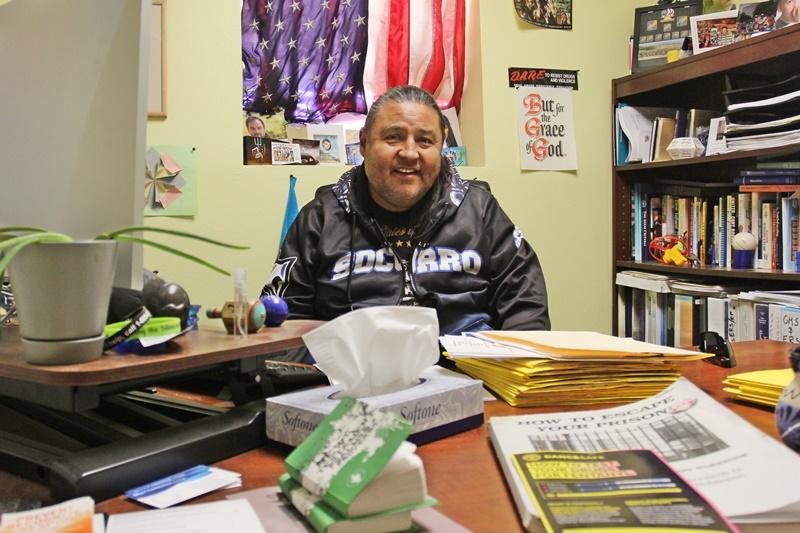
Peer support worker Jason Frame in his SCCAP office.
Cathy Cook | El Defensor Chieftain
The proliferation of fentanyl is the biggest challenge for the counselors, peer support workers and case managers trying to help people struggling with addiction at the Socorro County Community Alternatives Program (SCCAP).
SCCAP offers case management, some therapy, referrals, help navigating bureaucracy and peer support for people on pre-trial release or probation. The program has seen approximately 210 intakes for this quarter. According to Director Athena Gassoumis, more than 90 percent of SCCAP’s clients have had fentanyl in their system.
Fentanyl began to hit the local scene 18 months ago, Gassoumis estimates.
“I’ve been doing this for almost 30 years. I have never experienced a drug hijack an individual the way that fentanyl does,” said Gassoumis. “It makes treatment incredibly difficult. The detox process from fentanyl is physically and emotionally more painful than heroin or other opiate-like drugs. Most of the folks in the detention center currently are probably there for some kind of fentanyl use, possession of fentanyl.”
When people are arrested and need to detox, they are cleared by the hospital or typically given some medication to assist with detox and ensure it is safe, said Gassoumis.
“Our detention center is now predominantly used as a housing facility and sort of detox treatment facility, which is unfortunate because no detention center is set up for that.”
Gassoumis said that SCCAP is advocating to bring medicated assisted treatment for the detox process and recovery process to the detention center.
“That’s important because if somebody is not on some medicated assisted treatment before they are released, we have already experienced overdose and deaths from people being released from the detention center, being detoxed and their system not being able to handle the reuse of the fentanyl.”
Another challenge is an increase in NARCAN resistant fentanyl. NARCAN is used to reverse an overdose, which can be lifesaving.
Stopping use of fentanyl is extremely difficult because of the physical and psychological challenge of withdrawal.
“I would say it looks a lot like Linda Blair, this particular one,” said Gassoumis. “It really does. It’s incredibly painful. I’m saying Linda Blair because the graphics of that, if people know what “The Exorcist,” if they’ve ever seen the movie, then they also know that physically your body will secrete from pretty much every orifice you can imagine, and the pain will put you into a fetal position for a few days. It is really a pretty horrendous experience.”
If someone picks up use after experiencing detox from fentanyl, it can be difficult to convince them to go through detox again, said Gassoumis. But there are resources within Socorro County to support people who are struggling, including SCCAP, Socorro Mental Health, Cornerstone Counseling, Full Circle Recovery, Casa de Luz, New Mexico Tech’s counseling services and the SCOPE Health Council.
Peer Support
Jason Frame has been a peer support worker at SCCAP for five years, putting what he learned in his own 30-year struggle with active addiction to good use.
Frame’s office walls are decorated with motivational posters, artwork and inspirational quotes. Hanging between the motivational quotes are posters advertising past recovery rallies—an annual community event to celebrate people in recovery.
His favorite of the motivational messages is the four agreements: be impeccable with your words, don’t take anything personally, don’t make any assumptions, and always do your best.
“Be impeccable with your word. That means building up not tearing down,” said Frame.
Frame was in active addiction from age 13 to 46. At 19, Frame suffered a traumatic brain injury. He started at New Mexico State University with plans to become an aeronautical engineer.
“I started going to school, and I did all the things that I had to do, take notes, go to class, study. I would fail every test that I took miserably, so I lost hope. I was depressed. It just so happened that my roommate had a briefcase that was full of weed, marijuana. So there was my answer: don’t think about it. Just smoke my happy little self to oblivion.”
He withdrew after that semester, then tried again at the University of New Mexico, only to fall into the same cycle. Frame took up work as a cook and medicated his problems along the way.
By the time his son was born in 1995, Frame had graduated to manufacturing methamphetamine.
“I thought that I had wasted all those years, but in fact, I was learning a lot about that subculture and that drug world.”
That knowledge is what he uses to help others struggling with addiction figure out how to move forward.
“I’ve come to understand that addiction is the result of some sort of trauma. Some wound that has been incurred. Using substance to medicate feelings, problems, situations. Once you get to a certain point, the medicating is no longer medicating. It’s just feeding an addiction.”
Frame never used fentanyl, but currently it’s his “biggest nemesis.”
“A lot of people are using it, and they say they want to get off of it, but they’re unable to. I think it’s because of the withdrawals. The withdrawals are worse than heroin,” said Frame.
Frame used to judge his success as a peer support worker by whether the people he helped stopped active addiction, but he doesn’t anymore.
“I just see that some people do and that’s wonderful. I can’t do much for people who don’t want to help themselves. If I can show them that I spent a good portion of my life, I wouldn’t say wasted, but not doing what I wanted to do. My higher power was calling. Now I am a much better version of myself, the best version of myself, I can be.”
Although recovery is difficult, Frame is hopeful.
“What if one person pulls themselves out of addiction and into recovery? It’s a wonderful thing, and it is inspiring, and it’s contagious.”






















